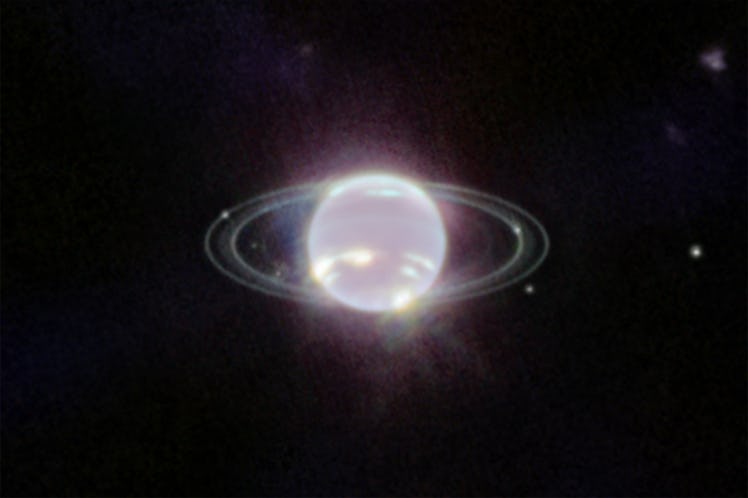JWST's Photos Of Neptune's Crystal-Clear Rings Are A Sight To Behold
NASA’s James Webb Space Telescope (JWST) scientists have captured the clearest view yet of Neptune, and it’s breathtaking.

In another out-of-this-world photo from NASA’s James Webb Space Telescope (JWST), scientists have captured the clearest view of Neptune, and it’s breathtaking. We’ve known Neptune has rings encasing its planet for a while, but we’ve never seen them like this before.
According to NASA, the new photos show some rings — Neptune’s faint dust rings — that “have not been detected since NASA’s Voyager 2 became the first spacecraft to observe Neptune during its flyby in 1989.” It also captured the planet’s brighter, narrow rings.
“It has been three decades since we last saw these faint, dusty rings, and this is the first time we’ve seen them in the infrared,” said Heidi Hammel, a Neptune system expert and interdisciplinary scientist for the JWST project.
The telescope’s extremely stable and precise image quality permits these very faint rings to be detected. The Near-Infrared Camera instrument on the telescope was able to capture the stunning photos because of its precise instruments, despite the faint rings being so close to Neptune.
Unlike other images taken of Neptune, the JWST photos don’t show the planet as blue, but as more red. “The methane gas so strongly absorbs red and infrared light that the planet is quite dark at these near-infrared wavelengths, except where high-altitude clouds are present,” NASA explains.
“Such methane-ice clouds are prominent as bright streaks and spots, which reflect sunlight before it is absorbed by methane gas. Images from other observatories, including the Hubble Space Telescope and the W.M. Keck Observatory, have recorded these rapidly evolving cloud features over the years.”
“More subtly, a thin line of brightness circling the planet’s equator could be a visual signature of global atmospheric circulation that powers Neptune’s winds and storms. The atmosphere descends and warms at the equator, and thus glows at infrared wavelengths more than the surrounding, cooler gases,” according to NASA.
The JWST was also able to capture images of Neptune’s 14 known moons, including a gorgeous look at the planet’s largest moon, Triton.
“Covered in a frozen sheen of condensed nitrogen, Triton reflects an average of 70 percent of the sunlight that hits it,” NASA explains. “It far outshines Neptune in this image because the planet’s atmosphere is darkened by methane absorption at these near-infrared wavelengths.” More JWST phones of Neptune and Triton are expected in the year ahead.
The JWST has done it again, and we’re excited to see what discoveries are next!
This article was originally published on